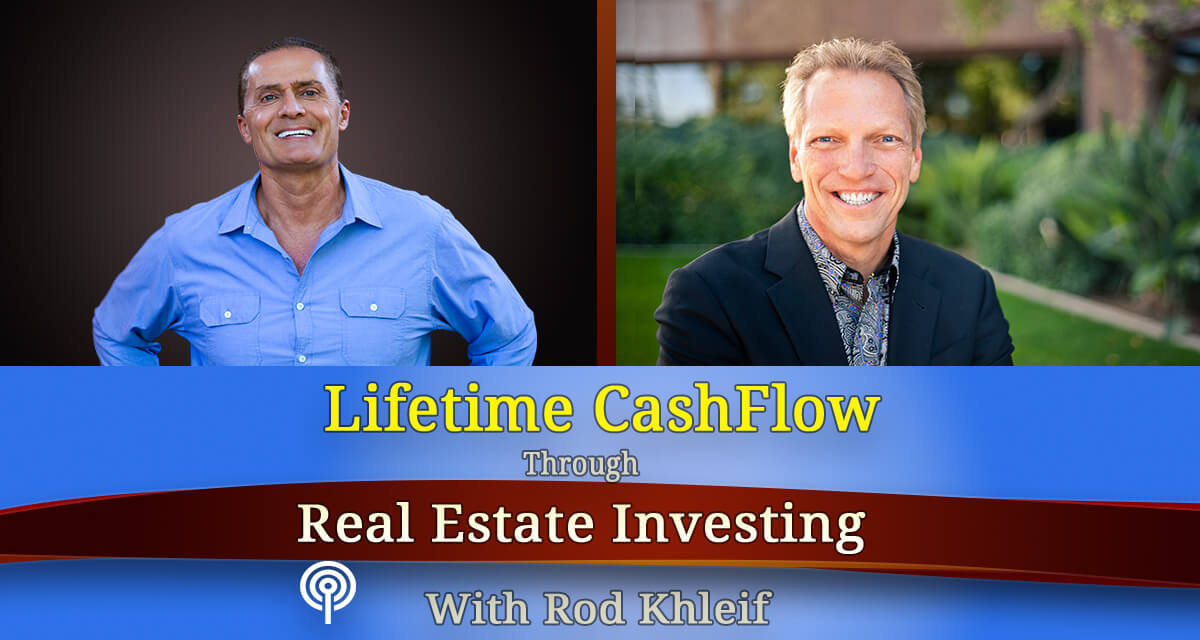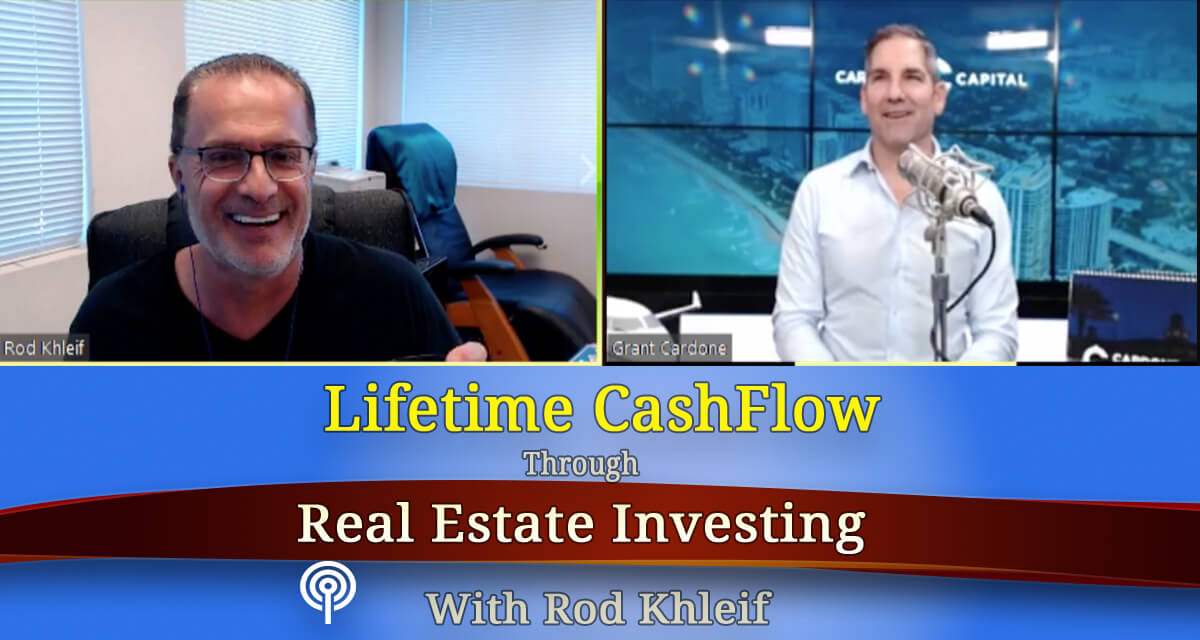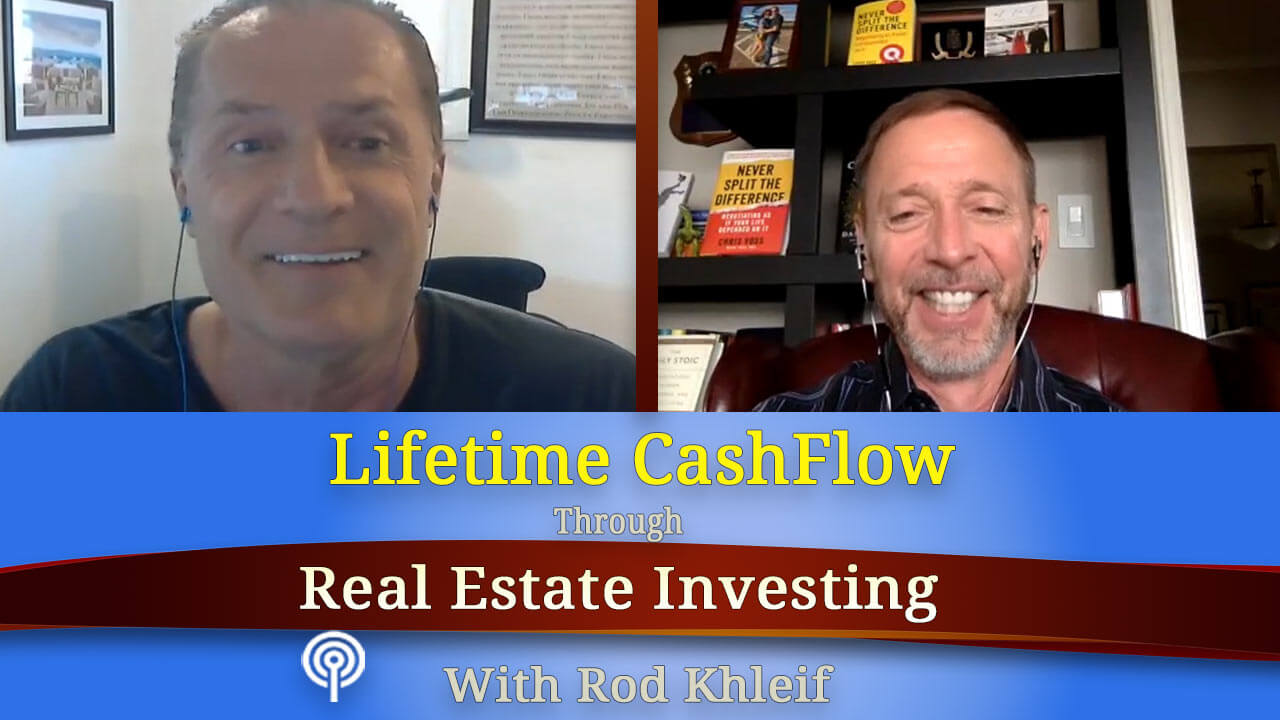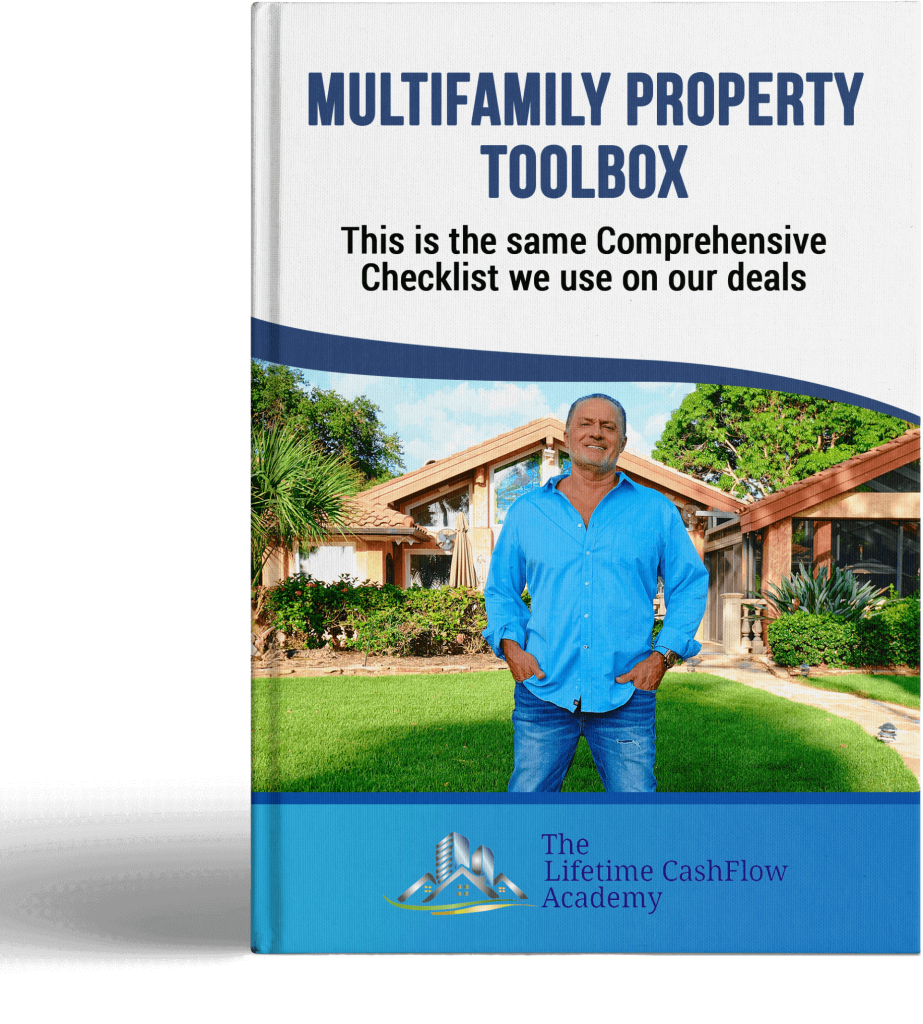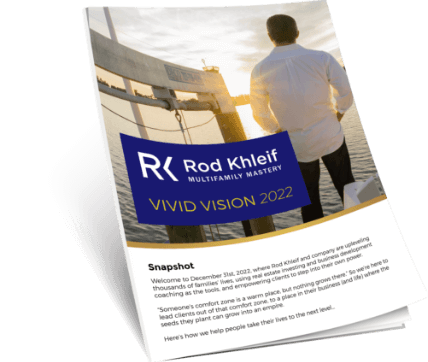Ep #507 – What first-time multifamily borrowers need to know.
Blake Janover advises borrowers on every part of the CRE investment process, from acquisition to disposition. Blake specializes in helping first-time borrowers get their deal done. Here’s some of what we talked about:
- Understanding the availability of agency debt.
- Non-recourse loans.
- Understanding Bad-Boy Carve Outs
- Importance of banking relationships
- Debt coverage ratio
- Triggering recourse
- PCNA – Project Capital Needs Assessment
- Yield Maintenance
- Understanding Covid Reserves
To find out more about our guest:
http://janover.ventures and http://multifamily.loans
Full Transcript Below
Ep #507 – What first-time multifamily borrowers need to know – Blake Janover
Rod: Welcome to another edition of “How to Build Lifetime Cashflow through Real Estate Investing”. I’m Rod Khleif and I’m thrilled you’re here. And I know you’re going to enjoy the gentleman we’re interviewing today. In fact, his name is Blake Janover with Janover Ventures, and Blake is an expert in the Multifamily Finance game and really Capital Markets with which is what they call it. And so, you know, he’s a member of the Forbes Real Estate Council like myself. He’s been in the business for 15 years, very knowledgeable guy. In fact, knowledgeable enough that I had him speak to my warriors, my mentorship group because I was so impressed with him. And we’re going to dig into a lot of fun stuff today. Welcome to the show brother!
Blake: Man, thank you for having me. I’m shy when you’re so generous. I hope I can live up to it.
Rod: You already have my friend. So, let’s dig into who you are, and maybe just real quick how you got into the business, and then, we’ve got a lot of fun stuff to talk about that I know is going to add a ton of value today. So guys, you definitely want to stick with this episode today. All right, let’s do it.
Blake: I’ll follow your lead. So, keeping it really brief, I’ve got about 15 plus years in Real Estate Capital Markets experience. It was my first real career and I’ve kind of stuck with it ever since. I survived the pretty banged up, although I know you’ve been there too but I survived the 2008 tsunami and came out the other end a little wiser and with a tad bit more humility. My background involves billions of dollars of Multifamily and Commercial Real Estate Finance transactions. I’m also a GP in deals and own units. So, I’ve kind of been all over the multifamily spectrum. And right now, our business is focused on, or what I’m doing my day-to-day life is focused on bringing technology removing frictions in this small Multifamily Finance space between one and ten million dollars–
Rod: Yeah. Guys, that is the small multifamily space just so you know, between one and ten million. So, you know, I know you also specialize in really first-time borrowers which is why I really wanted you guys to listen today. And so, you know, I know you, you know, which is unusual. A lot of the brokers that I deal with, you know, they get frustrated because there’s so many questions and, you know, and things that, you know, a first-time borrower, you know, when you’re doing your first deal, you know, that you’re a newbie and you really just don’t know what you’re doing. And so, the fact that you do that, is a big deal. And, you know, so let’s talk about maybe some suggestions you might make if someone has a deal and they’re going to come to you and it’s their first or maybe probably their first, you know, what suggestions would you make to them?
Blake: Well, and this is genuine. So, my first suggestion is, if it’s your first deal, you should be on Rod’s boot camp. You should be figuring out how to get in on that.
Rod: Thank you. And, you know, I appreciate that and I’m probably gonna have you speak at the next one, Blake, as well to really, you know, drill down on the different, you know, the different financing options that are out there but that said guys, if you are interested, go to multifamilyvirtualbootcamp.com or text “multifamily” to “41411”. You guys know that I do these two-day boot camps. I don’t sell anything at them and Christ, if you get in early enough you can get in for as little as $97 or $147 respectively. So, it’s truly a no-brainer but thank you for that plug my friend.
Blake: Well, it’s deserved and hopefully I don’t botch up this podcast and you have me on the next boot camp. So, the pressure’s on. Listen, as far as suggestions are concerned, if I can make a stop before I go to suggestions is, can I just briefly let people know, kind of, what their options are in which we’re gonna talk in your bootcamp?
Rod: Yeah, that’s even better. Yeah, let’s do that. Thank you.
Blake: Yeah, I just want to kind of preface the suggestion part. So, I think there’s some misinformation out there and that’s that all Fannie Mae lenders, make Fannie Mae loans, all Freddie Mac lenders, make all Freddie Mac loans. And the reality is that, every lender has their own prerogatives and their own credit boxes. So, they don’t necessarily have to do everything that Fannie Mae allows. There’s Freddie Mac programs and some Freddie Mac lenders don’t have. There’s Fannie Mae programs that some Fannie Mae lenders don’t do. And I think a really good example is that, you can be a first-time multifamily buyer, a first-time agency borrower, and still get a Fannie Mae multifamily loan.
Rod: By the way, agency means Fannie Mae and Freddie Mac, guys, just see if you don’t know what that means. Okay, keep going.
Blake: Sorry about that. So, really high level. There’s a few active buckets right now. There’s Fannie Mae multifamily, this is really good for first time borrowers, secondary and tertiary markets, small markets. This is really good if you want to get a 30-year fully amortizing multifamily loan and it starts at a million and up. But remember, there are 30-year fixed loans for apartment buildings. It’s another thing that not everybody really knows about. They’re non-recourse which means, there’s no personal guarantee if something goes wrong and you’ve behaved well, meaning that you have insured of any “Bad Boy” carbonates. These are guarantees you make not to do things like tax evasion or something meaningfully illegal, but if something goes wrong, you lose the property, you give back the property, you give back the company but nobody comes after you personally.
Rod: Right. So, as far as those “Bad Boy” carve outs, that’s what they call them guys. That’s kind of sexist I guess because they’re bad, it’s for bad girls too. But anyway, you know, again you can’t commit fraud. You gotta keep your taxes paid up. You know, it’s stuff like that, but if you don’t do any of that silly stuff and you’ve got to pay attention, you know, as you’re managing the asset as well that you don’t go counter to the agreement. In fact, because like, we’ve got an asset right now that we’re changing the GP structure on and we had to get Fannie’s approval before we did that otherwise we could trigger recourse. So, you just involve an attorney to make sure that you’re not doing anything improper that could trigger the “Bad Boy” carve outs, otherwise again, if they foreclose all they’re going to take is the property, that’s it. There’s no hurt to you at all. I mean, it will hurt that you won’t be able to get more Fannie debt after that but they can’t come after your personal assets. All right, so please continue my friend.
Blake: By the way, with a good story, you can get Fannie debt after that. We’re doing a Fannie deal now for someone that defaulted on the past.
Rod: Oh no! Okay. Well, there you go. Okay.
Blake: So, we’ve got Fannie, we’ve got Freddy, Freddy has a great product too. It’s really good in big markets. Think like, the New York, and LA, and the Miami is a very competitively priced product with more flexible prepayment penalties which we’ll talk about in just a moment. There was CMBS, it was big now, it’s kind of–
Rod: CMBS guys, sorry to interrupt is, Commercial Mortgage-Backed Securities. This is what caused the ‘08 crash where, you know, these loans were sliced and diced and sold on wall street. Nobody really knew who owned them. And that market still exists in the, and has existed past that in the commercial multifamily space but it literally has dried up in the lat, you know, because of Covid. Is it coming back at all or is it still pretty gone?
Blake: It is, we– it’s coming back slowly. It’s really tight. It’s conservative like most lenders are right now. So, lower leverage, more reserves, the same story, but it’s slowly coming back highly selective, right? For agency, Fannie and Freddie fallout and things like that. Banks are really active right now, but there’s execution challenges, right? Because a bank– there’s, I always hear the story, right? I got a term sheet from my bank, and I say, “Well, you know, a term sheet is worth just about what it’s written on.” And people are getting retreated and banks are changing the deal later or pulling the deal. So, the only way to get real certainty of execution with a bank, is if you’re coming with deposits or you have deposits. If you’ve got deposits, you’ve got, you know, you’ve got a trump card.
Rod: You know, you want to build relationships with them and banks are relationship-driven and of course, the best way to start a relationship is to open an account. Okay? Even if you’re, you know, even if you don’t throw like, you know, like Blake said, “If you’ve got a deposit relationship, give a much better shot.” You know, the term sheets that he was talking about are always negotiable. And they, and like he said, “They re-trade them” meaning, you get to closing and they change their mind about something. So, you know, it’s until it’s locked, you know, you really don’t like he said, “It’s not worth the paper it’s written on.” But you want to build relationships with bankers and here’s why, you know, I’ve literally, I’ve got students that have been offered 100% financing on multifamily properties because of the relationship they had with a bank. I’ve got, you know, I remember when I first interviewed, started interviewing like three years ago, I interviewed a kid that got a million dollar deal done with $5000 down with bank financing because the seller allowed, I’m sorry, the banker allowed the seller to carry a second. Now again, that’s relationship-driven now, that those are anomalies I would say, that happens all the time but those relationships are important, number one. Number two is, you know, if you’ve got some relationships with banks and things do go South and they start taking some properties back, I can tell you, if you listen to my podcast, you’ll hear some of these guys that, you know, started in 9, 10, 11, they got bank financed for bank real property. So, that opportunity exists as well. But let me say this, Blake. What someone like Blake does, is he gets you lined out with the correct financing for your deal. Be it agency debt, be it maybe bridge debt even. I’m assuming you can coordinate that as well. And then, also of course bank financing for, you know, he’s got relationships with banks. And, to give you a plug Blake, one of the advantages of having someone like Blake and his company, as a middleman, is a horrible expression, but that’s really kind of what it is. You’re representing, he’s representing you, when you are communicating with the bank, when you’re communicating with the agency lenders, so that you present yourself in the right way. So that, you know, if you decide you’re gonna give them some information, it’s the information that’s going to help you, and he can help position it so that you have a much better chance of getting approved. And so, that’s why using, you know, a broker, would you call yourself a broker, Blake? Is that–
Blake: An advisor? An intermediary?
Rod: Okay. All right, there we go, intermediary. Okay, that’s better than middleman, okay. Anyway, but that’s why we highly recommend that, especially if you’re newer in this business. So–
Blake: Let me just comment on that for a second. Just to comment on that one piece. It’s important even if you’re sophisticated and you’ve done a lot of deals, right? And we have borrowers that have portfolios worth hundreds of millions of dollars and they still come through us. And one of the reasons is, because it’s good to have a filter, right? You send us a document and we say, “ Whoa! What’s going on there? Walk us through that. How does that property management fee include staff, payroll? What’s included in there? What is this line item? What’s that line item? How does that work?” and you don’t want to give a mess to a lender because the lender will immediately get turned off and you’ll have to go find another lender. The other reason is, because lenders have misaligned incentives. So, if I’m a lender, let’s say I’m an agency lender, I do Fannie Mae and Freddie Mac and I have a line of Fannie small and Freddie small. And one of these products–
Rod: Okay. Hold on. Sorry.
Blake: Yes.
Rod: What he’s talking about is small balance loans guys. When he says, Fanny small and Freddie small, he’s talking about their small balanced loan programs and what are the numbers on that?
Blake: Other, a million and up.
Rod: A million and up, but a two, 10? Is that two 10 there or is that less than 10 on the small balance?
Blake: From a rate perspective?
Rod: Well, just from a description perspective when you’re talking about their small balanced loan programs, at what point it’s no longer in the small balanced loan program?
Blake: Okay. So there’s exceptions, so it’s generally one to seven million, but you can get exceptions above seven.
Rod: Yeah. That’s what I was looking for. Okay. So, I’m sorry, hopefully I didn’t completely throw your train of thought off, I just want to let people know if there’s a term they haven’t heard before, that’s all.
Blake: No, it’s important. So, I was talking about misaligned incentives. So I’m an agency lender, I make Fannie Mae, Freddie Mac and FHA multifamily loans which we could talk about after. And I’ve got a Fannie small balance family and a Freddie small product, right? And the Freddie small product is better for you but I close a lot with Fannie and it’s easier for me and it pays me more. You’re getting a Fannie loan, that’s it. And if you don’t have somebody in the middle, the right person in the middle, right? The wrong person in the middle–
Rod: So, what you just described was the lender taking that position. If you went directly to the lender, they would push a product on you that’s better for them.
Blake: Hopefully they won’t.
Rod: Not necessarily better for you. Right. But that’s possible. But that’s where you come in to help delineate the best product and I like the filter, I like that term much better. I’ve got to remember that because that’s really the bottom line is, you’re able to filter out, you know, the things that the lender doesn’t need, things that will confuse or irritate the lender and help facilitate that back and forth because you know what they want to see. And, you know, very often an operator doesn’t. So, okay. So, please continue with that thought if there was more on that.
Blake: So, there’s actually somewhere else I can go from it. I just don’t know if we should go too far off path but I have a couple examples of deals like that where we were kind of in the middle and it made sense.
Rod: No, go ahead. Explain. No, I’d love to hear myself. So please go ahead.
Blake: So, we had– So, I’ve got a few deals we did recently. One of them was with a first-time multifamily borrower, not local to the property. So, far away from the property in another state. And in this case, we had to assist him in finding another qualified sponsor. So, he actually sent us a list of everybody that he knew that he thought might be a possible Co-GP, a member of the general partnership with him to sign the debt and we went through and we vetted every single one of them and picked the person for him–
Rod: Wow!
Blake: To do his deal–
Rod: Wow! That’s quite a service. Okay, fantastic.
Blake: And by the way, on agency, we’re almost never charging a fee to borrowers. We’re doing rev share with the lender. So–
Rod: Fantastic! So, the second example.
Blake: So, we just closed a deal. The borrower had only six months of multifamily experience. Never did an agency deal, wasn’t local to the property, and was also renting the units by the bed to start. So, what we had to do was, we helped coordinate with him to find an acceptable property manager to pivot from bed to unit leases. Got him qualified and close that loan for him.
Rod: Fantastic!
Blake: And that was a hairy one also. And, you know, we’ve got another one with a property that’s stabilized but there’s a bunch of down units. But the units don’t have to count against occupancy because they’re down and they’re getting renovated and we’ve got a waiver for that. So, there’s no really fixed box. There’s a good story and a good asset, and a good borrower. There’s a creative way to get it done.
Rod: Explain what Fannie and Freddie look for as far as it relates to stabilization.
Blake: 90 days of 90% occupancy is their number, depending on–
Rod: Remember this guys, 90 for 90. Memorize that. Okay.
Blake: 90 for 90. And then, you know, they’re looking at things like debt service coverage ratio which is the relationship of your mortgage payment to the property income. So–
Rod: Explain that. Explain that with a little more detail if you wouldn’t mind.
Blake: Sure. So, if your property is earning $120,000 a year in NOI and your mortgage payments are $100,000 a year, that’s a 1.2 debt service coverage ratio. Your property’s income is 1.2 times your annual debt service.
Rod: And the absolute minimum that most banks and agency lenders want to see is 1.25. And so, because guys, what they’re looking for, is the property’s ability to service the debt much less your ability to service. It’s really about the property’s ability and that’s what that debt service coverage ratio is. Now, that debt service can be, that ratio can be higher in certain circumstances as well, correct?
Blake: Yeah, and if the debt service coverage ratio is higher, you’re getting a lower rate, better terms some interest only, a more flexible prepayment penalty perhaps. So, it’s all kind of intertwined. If you pull one place, you’re getting some push somewhere else. So, yeah. And by the way, you mentioned something before and I took note of it with my number two pencil because I use a number two pencil and we were talking about “Bad Boy” carve outs and it’s generally, if you do something that’s, would constitute a “Bad Boy” or a “Bad Girl” move. However, if you’re an experienced borrower and you’re doing complex bank deals and things like that and you’re getting a non-recourse loan, something that non-recourse lenders have done over the last few years, is slip in provisions that would essentially trigger recourse that have nothing to do with “Bad Boy” carve outs. For example, something that lenders will slip in sometimes is, you have to send us your annual financial statement within 90 days of the end of the year. And if you don’t do that, you are technically in default. So, read the carve outs carefully because it’s not just broad behave yourself. There are things slipped in there that are meant to deceive.
Rod: Well, I’m going to tell you better than that. Make sure you’ve got an attorney that really knows what they’re doing, reviewing those as well because there’s a high level of detail in that review. And, is that negotiable? Just a question. I don’t even know the answer to if you, if you get a document like that and they’ve slipped that crap in, is that negotiable, is that something an attorney can say? You know, we don’t want that in there or is that not going to be happening?
Blake: Everything’s negotiable.
Rod: Okay.
Blake: If you’re doing a $1,000,000 Fannie Mae multifamily refinance?
Rod: Yeah.
Blake: It’s not negotiable.
Rod: Right.
Blake: If you’re doing a $10,000,000 CMBS loan? It’s all on the table. Everything’s negotiable. And by the way, speaking to your attorney comment, right? The most important thing, this is the first question you asked me that I totally didn’t answer, but you said, “What’s your advice to somebody that’s borrowed, that’s a first-time borrower?” and I said, “Join Rod’s boot camp because it really is the right thing to do and I mean that, I get zero compensation for saying.
Rod: Right.
Blake: And the other thing is to build the right team, that means, you don’t get a residential attorney or a traffic ticket attorney to look at commercial mortgage documents. And you don’t get a single family property manager or commercial property manager to manage a multifamily property. These things are really unbelievably important and one of the wonderful things about using a Fannie Mae or Freddie Mac lender, not that they’re the only game in town but because they’ve done tens of billions, hundreds of billions of dollars of loans of multifamily loans. They know what to look for, they know who to hire to look at the property, they know what appraiser to use, what PCA inspector to use, what environmental a study to use. So, they’re doing due diligence for you and it’s pretty much free.
Rod: Yeah, and explain what PCA is, please.
Blake: That’s a Project Capital Needs Assessment or PCNA. It’s what an agency lender would use to determine what kind of work is needed in the property immediately and over a period of years. So, they may do an assessment and say, “Okay, there’s a life safety issue in the parking lot. There’s a hole in the parking lot that somebody can fall into and you have to fix that before closing and we think the economic life of your roof is seven years and we’re going to start reserving money up front so that when the seven years come, you have money in reserve to compensate for replacing the roof.”
Rod: So guys, when they do that, when they order that PCA study and they get it back, they’re going to tell you what your reserves are going to be, that they’re going to require to hold for that asset for things like roof, and HVAC, and parking lots, and whatever else can break down. And I will say that, that is also negotiable but, you know, that’s just something that’s very often forgotten. Now it’s your money, when you fix that thing, you’re going to get it back but, you know, you’ve got to factor that into your returns. So, first-time borrower, yes of course come to my boot camp, duh! But yeah, get it, you put a team together and you put a team that knows what the heck they’re doing that’s, you know, in the business, in the commercial multifamily business, not residential multifamily business and, you know, an attorney that knows commercial contracts and a property management company that manages assets like the one you’re buying.
Blake: Very intermediary.
Rod: Yeah, and a great lending intermediary or advisor or filter like Blake.
Blake: A middleman.
Rod: So, anything else that you could say to a first-time borrower?
Blake: Yeah. So, this is important. Let me choose the right words. Returns are risk adjusted when you see an 18 cap on loop net and you think, “Wow! I’ve hit the jackpot.” Something my mother would say to me is, “Why are you so lucky?” And generally speaking, I’m not so lucky. So, when you see an 18 cap, some things you may want to consider are, is my life in danger when I go to collect the rent? Is the property even legally zoned? I’m not saying that great deals don’t exist but usually if you find a great deal, it’s through a relationship. It’s off market. It’s not in a giant public marketplace that everybody can see and everybody in the world has access to. So, be considerate and like the– something I just want to add to that, right? Is generally speaking, this isn’t a fixed rule but it’s a rule of thumb. If I’m getting a low cap rate, that means, I am in a dense, economically active market and there’s my income is low but my chance for appreciation may be bigger, non-cap rate related appreciation, whereas if you’re buying something with a high cap rate, you’re taking your gains now, in many cases, in current cash flow but your appreciation may be less substantial.
Rod: If it’s at all and the exit strategy may be non-existent because you know, you’re really just buying cash flow and if you’ve got a high cap rate, chances are you’re in the hood, okay? So, let’s just call it what it is and that’s the truth of it. And I got to tell you, I talk about this in great detail of my boot camps where I bought properties in the areas in D properties and I regret every single one of them. And some of them on their face looked like screaming deals but I regret every single one of them. So, okay.
Blake: Gentrification happens in these small markets but it’s hitting a roulette table in the casino unless you have insider information.
Rod: Listen. Let me say this. Yes, areas gentrify as well. I mean, I could tell some pretty amazing stories about gentrification. I’ll give you one real quick. I bought a four-plex for what was it? $80,000 for all four units. Two storey, three bedroom, two bath units each, garage behind them, I paid 80 grand for the whole building. Each one of those units now is worth about somewhere between $700,000 to a million, you know, in Denver, where it gentrifies. So, that is possible but you’re going to deal with– We found a dead body in there at one time, okay? So, you know, I’m just telling you that you got to deal with that exact property actually. So, yeah.
Blake: That’s an agency issue. They’re going to look to see if there was crime on or around the property in the last year. If there’s dead bodies and garbage cans, you’re not getting an agency.
Rod: Right.
Blake: I hope you have a good bank relationship on that one.
Rod: Right. Anything else for a first timer or can we go ahead and move on to prepayment or yield maintenance?
Blake: Let’s move on.
Rod: Okay. So, let’s talk about prepayment, you know, in the single family space that’s what it’s called in the multifamily, you know, larger multifamily, it’s called “yield maintenance”. Can you speak to that a little bit and how you can mitigate it?
Blake: Sure. So, yield maintenance is a type of prepayment penalty or if you want to sound fancy when you’re talking about it, you can call it “Call Protection”. That’s what people in the know might call it but there’s yield maintenance which is one. We don’t want to get into the mechanics of it but it’s generally going to be more expensive. Deficience, which we really don’t want to talk about although and that may be more expensive as well. And then, there’s step down prepayment penalties. So a step down prepayment penalty is kind of like how it sounds. If it’s a ten-year loan, it may start at ten percent, a ten percent of the loan amount for the first year, if you pay it off. And then the next year, nine. Next year, eight percent, seven, all the way down to one. Now, there’s different kinds of step-down prepayment penalties. So, there may be a softer 10-year step down prepayment penalty which may be like, 5-5-5, 4-4-4, 3-3-3. So on and so forth. Freddie Mac has a free max small balance, has a couple products where they have really light prepayment penalties and I’m not going to quote it right but I think we’ve got a five year where it’s like, 3-2-1 and then 0-0. And you have to pay for it, right? Like anything else. You want to get rid of the yield maintenance? You want to have a step down prepayment penalty that you can understand– that you can really predict better? You’re going to pay a little bit in the rate 10, 20, 30, 40 basis points depending on the type of loan and everything else. Prepayment penalties don’t generally go over 10 years. So, if you have a 30-year loan? You’re getting a 10-year prepayment penalty and everything’s going to be okay after the taking.
Rod: After the 10 years, yeah. By the way, basis points guys, they’re also called ‘Bips’ and there’s 100 basis points for every one percent interest, okay? And that’s how you basically carve up a percent interest. You get, you know, 50 basis points it’s a half a percent just to clear that up for the brand newbies.
Blake: Okay. When dummies like me want to sound smart instead of saying one percent, I’ll say 100 bips or 100 basis points.
Rod: Right.
Blake: So, sorry for that.
Rod: It’s all right. So, let’s talk about anything else, Covid related. Well certainly, let’s talk about the new reserves and anything else that comes to mind as it relates to Covid.
Blake: Sure. So, the Covid reserves, Fannie and Freddie used to have a top of around 80% LTV and it still is except for the fact that you’re ponying up six to 18 months reserves if you’re borrowing more than 55% LTV.
Rod: And this is new, guys. Okay? So, you used to be able to get 80%, you know, loan to value, no reserves like he’s speaking about here other than, of course, reserves for CapEx but future campaigns, but PCA. But, this is new because they see the volatility in the market so they’re requesting six to 18 months of principle and interest of what your payment would be in a reserve, just in case. Now, when you get it back?
Blake: So, everybody’s got different rules around it but the rule of thumb is that, if you have continued economic occupancy–
Rod: Right
Blake: Not physical occupancy
Rod: Alright. Hold on, let’s stop there for a second. Okay. So guys, there’s a difference between physical occupancy and economic occupancy. Obviously physical occupancy is bodies in units, one body’s the wrong word in light of our recent conversation, people in units but economic is the ones that are actually paying which is really relevant in this Covid world we’re in with eviction moratoriums and the CDCBS and all that stuff going on. So, back to your comment about, is it continued economic occupancy? Does it need to improve or does it just at least need to be stable?
Blake: Yes stable, you know, about 90% or I don’t know–
Rod: Right.
Blake: The most recent number is, but it’s about that. And by the way, there is nothing worse than a building right now, with a 100% physical occupancy and no economic occupancy. That means, you got a bunch of people in the building that you can’t get out and that aren’t paying you.
Rod: So, it’s happening in New york a lot in some of the Blue States that are, they’re really strict on this. But, yeah. So guys, so after what period of time though? I don’t think I’ll let you–
Blake: 12 months.
Rod: 12 months. So, after a year of stable economic occupancy or improved, you’ll get that reserve back. But you got to factor it in up front, you know, as–
Blake: Don’t quote me on that it might be 18..
Rod: Okay.
Blake: My screen is 12 to 18 months
Rod: 12 to 18 months on that, on getting that six to 18 months of reserve back, okay? So, you’ll get that PI back but– and you can factor that in when you’re doing your pro formas but just recognize that’s going to go into the bank initially. So, what– anything else Covid related that you’ve seen an impact on other than CMBS market just falling away for a while?
Blake: So, I’m going to say something that people are going to think is crazy and I’m going to preface it with Covid has had a terrible impact on some properties, think multifamily in Manhattan, think student housing just decimated, right?
Rod: Retail office. I’ve got friends that own a lot of retail that their number, they’re telling me 70% of their tenants need help. So, it’s a big deal and, you know, a lot of retailers have gone out of business. Anyway, please continue.
Blake: So, the thing that I want to point out is that we have to disaggregate these things like break them into smaller pieces. So, retail is hammered.
Rod: Right.
Blake: Single tenant, triple net, credit tenant retail, doing fine.
Rod: Right. By the way guys, that’s the Walgreens and the CBS you see on the corners where there’s one tenant in a building and they don’t the– Walgreens burger kings. Yeah. They don’t own the building. They’re called single tenant retail and yes they are doing fine, please continue. I just want to clear, expand on stuff that you throw out there. Okay.
Blake: Yeah, I’m sorry. So–
Rod: That’s alright.
Blake: Other examples, office hammered.
Rod: Right.
Blake: Long-term leases in office buildings in Manhattan where there’s great tenants on 20-year leases, doing fine. Those buildings are going up in value because those tenants are paying their rent whether they’re coming to work or not. And that, you know, that’s important to share. So, what I want to point out is that, in multifamily, if you have an apartment building that’s been resilient, that’s continued to collect over 90% of collections, right? That’s performed well. It’s been resilient. Well, what’s going on right now is that there is this giant spread between treasuries, like the 10-year treasury and cap rates. You see, the 10-year treasury has gone down really low and cap rates have either stayed the same or maybe climbed a little higher. And traditionally, there’s a fixed number between what treasury rates are and what cap rates are and it’s spread really wide right now. And I think, for whatever the heck it’s worth, is that, the properties that have performed well should experience, it’s a crazy thing to say and it’s not something to base a business model off of, but should experience cap rate compression as the spread reduces and cap rates compress and come down closer to where treasury yields are because you’re going to be proven to have an investment that is resilient and safe and yields more than treasuries and it survived and performed well during a pandemic.
Rod: By the way, cap rate compression means values go up, guys. That’s, you know, cap rates counterintuitive, cap rates go down, values go up, the cap rates go up, values go down. Okay.
Blake: That’s right
Rod: Anything else on the Covid business or–
Blake: No, I’m tapped. You know everything I know now.
Rod: Well, listen brother. I really appreciate you coming on the show and I’m looking forward to, you know, really having you speak at my boot camp and really drilling down on just the nitty-gritty on each of these different types of finance and so on and so forth, again, what’s your website?
Blake: Janover.ventures, it’s not “.com” or “.net”. Actually, can I just add, I think that a more interesting site for your listeners and viewers would be “multifamily.loans”. So, that’s “multifamily.loans” not “multifamily.loans.com”
Rod: Okay, and there’s some resources there, correct? I think you mentioned that previously. Yeah. So, things that you can– Okay, so listen. Thanks for being on the show brother. I really appreciate you being here and I’m sure we’ll talk very soon.
Blake: Thank you so much for having me Rod. I really enjoyed this.
Rod: Good. Thank you, likewise.
Ads: Rod, I know a lot of our listeners are wanting to take their multifamily investing business to the next level. I know you’ve been hard at work helping our warrior students do just that using our ACT methodology which is Awareness, Close, and Transform. Can you explain to the listeners how they can get our help?
Rod: You bet. Guys, we’ve been going nonstop for three years building an amazing community of like-minded people and our coaching students which we call our warriors have had extraordinary results. They’ve purchased thousands and thousands of units and last year we did over a thousand units with our students. And we’re looking to grow this group and take it to the next level. We’re looking for people who wanna follow a proven framework that’s really step by step and then leverage our systems and network to raise equity, to find and close deals, and to build partnerships nationwide. Now our warrior community is finding success in any market cycle. So, if you’re interested in finding out more about how you can become more of our incredible network and take advantage of the incredible opportunities that are coming very soon, apply to work with us at “mentorwithrod.com” or text “crush” to “41411”. That’s “mentorwithrod.com” or text “crush” to “41411”.






